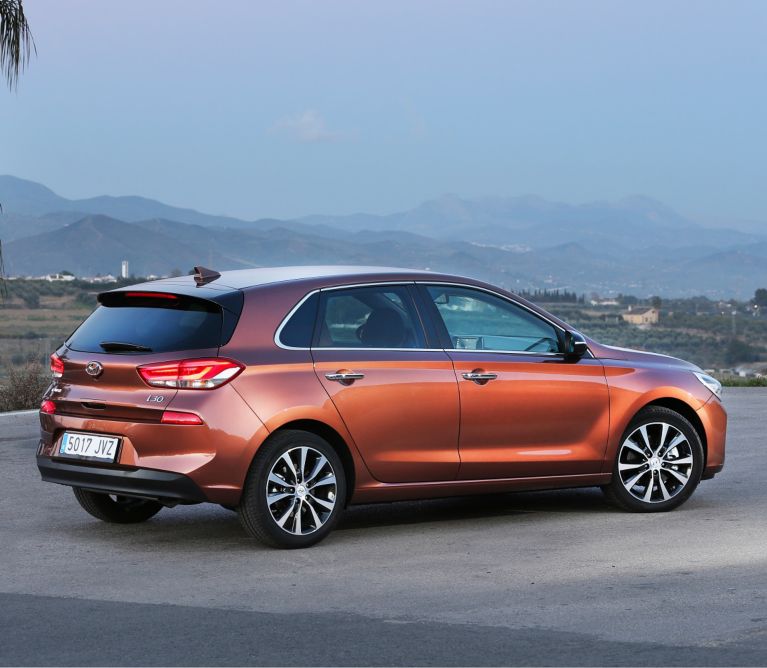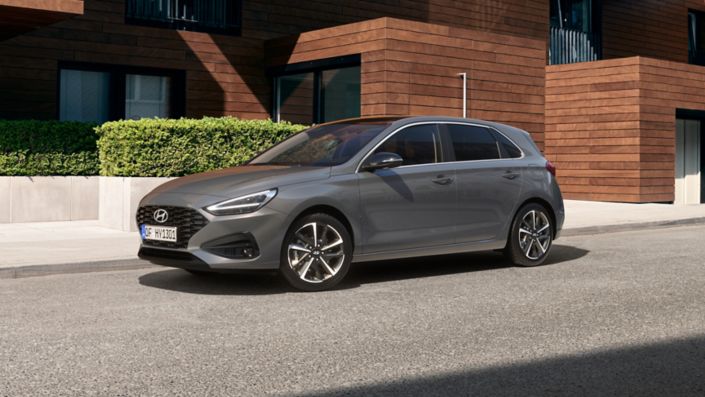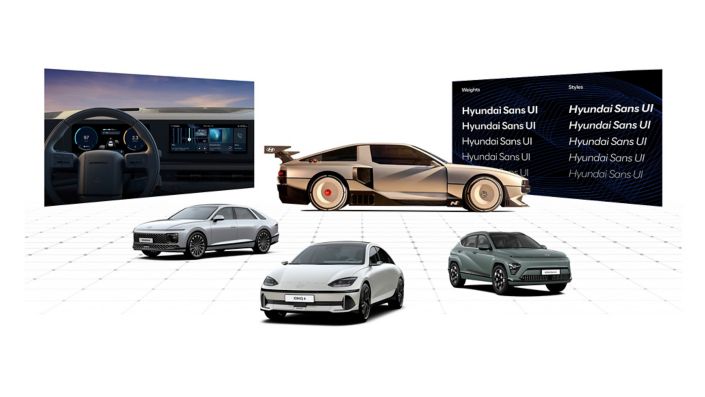That said, simplicity in design doesn’t necessarily mean simplicity in development. Hyundai’s process involves designers rearranging and modifying more than 25,000 complex components multiple times along the way. This dedication and passion has become the engine and the starting point of an automotive design that continues to turn consumers’ imagination into reality.
Hyundai takes about a year-and-a-half to two years to complete an automotive design from the first sketch to the final product. The timescale may seem short compared to other manufacturers, but the company makes no sacrifices of perfection and quality in order to keep up the speed. Nor does it let its imagination be confined by a design’s guidelines – Hyundai always aspires to create new trends, rather than follow any that already exist.
Hyundai takes about a year-and-a-half to two years to complete an automotive design from the first sketch to the final product. The timescale may seem short compared to other manufacturers, but the company makes no sacrifices of perfection and quality in order to keep up the speed. Nor does it let its imagination be confined by a design’s guidelines – Hyundai always aspires to create new trends, rather than follow any that already exist.
The essence of all great creative products can be summed up by just one word: simplicity. All best-selling cars start from a simple motif that allows people to recognise its characteristics instantly.
Design planning
The first stage of the process is design planning. Here, the challenge is to spot a trend that will be loved not only in the present, but in the future too. Hyundai studies local trends and consumer lifestyles from around the world in order to create original images and concepts.
The collected research is delivered to the company’s design studios in Europe, Korea and in California, where it becomes the outline for sketches of the car’s exterior and interior. While this process is analytical, based upon cold hard rationale and statistics, the next phase of development is where emotion, inspiration, creativity and intuition all come into play.
Hyundai’s designers take inspiration from everything that constitutes their surroundings. Art, music, travelling and even the sports they like can help inform a unique motif. For an example, the new Tucson’s exterior displays a strong silhouette that was inspired by the sport of parkour, an athletic discipline that involves running and jumping from one point to another in a complex urban environment. Similarly, the beautiful lines of the Tucson’s interior were inspired by legendary architect Eero Saarinen’s TWA terminal at JFK airport. Essentially, the sources that provide fuel for designers’ imagination are infinite.
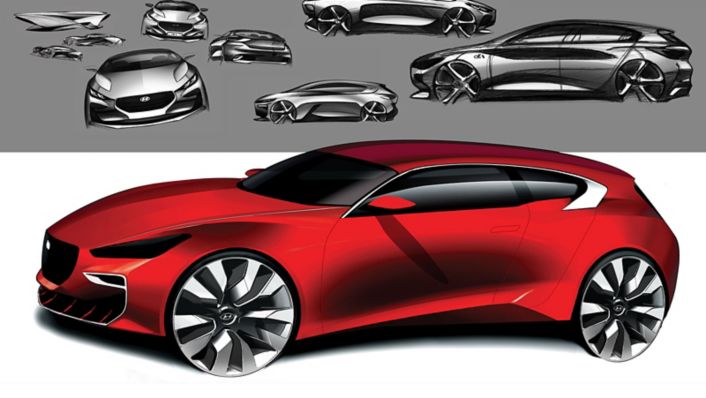
Sketching, rendering and scale modelling
Based on the concept that was established at the planning stage, various idea sketches and renderings help the foundation of more specific designs. With these established as an outline, the exterior design is made into a clay model a quarter the size of the real car. For the interior design, the concept is developed into a virtual model using 3D modelling software. Once ready for presentation, the wide range of designs made at Hyundai’s three global design centres enter a competition and are presented to the management board in Korea that decides which designs will make it through to the next round.
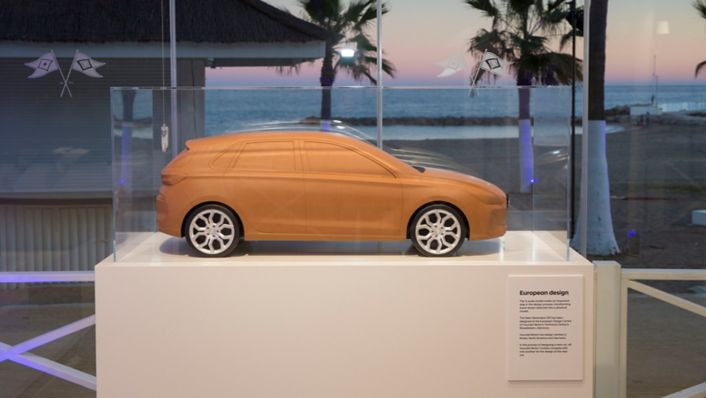
Digital (CAS) modelling
Next comes computer-aided styling, the process of converting the sketches into three dimensional representations, followed by revision and improvement work on the detailed design. This is recreated through a computer-generated 3D image, whose data is then used for assessing design and aerodynamics.
VR presentation
Afterwards, several designs are selected and recreated for evaluation using virtual reality technology. At this stage, specific directions are reviewed and details checked before Hyundai’s designers come up with the final design product.
1:1 scale clay modelling
Prior to the actualisation of that design, a 1:1 scale clay model that represents the final product is developed. The industrial clay is easily scraped, so the modellers can shape it as finely as if they were making a sculpture. Even at this stage, they can freely express and revise the car’s design. In addition, the interior design can be actualised into real one, so that the texture, feeling and smell can all be sensed.
Clay modelling is a complex procedure and time consuming; for this reason, many car manufacturers omit this stage and substitute it with ‘virtual’ and ‘simulation’ models. But without it, it would not be possible to see the physical lines, shadows and feeling of the overall exterior. For this reason, Hyundai regards clay modelling as a critical element of the process, given the company’s commitment to the highest levels of human touch and emotional involvement.
Emotional and colour design
To add an exclamation mark and complete the design with a flourish that stirs the emotions, Hyundai’s designers combine thousands of colours and experiment with combinations of finishes, patterns, materials and textures, challenging themselves until an aesthetic that is a step ahead of current trends is discovered. Only then will the company bring the design to life and offer its newest car to the world.
Consumption Data*
i30
Gasoline Engines
1.4 MPI (100 PS): Fuel consumption combined: 5.6 - 5.4 l/100 km; urban: 6.8 - 6.6 l/100 km;
extra-urban: 4.9 - 4.8 l/100 km; CO2 emissions combined: 130 - 126 g/km
1.0 T-GDi (120 PS): Fuel consumption combined: 5.0 - 4.5 l/100 km; urban: 5.8 - 5.4 l/100 km;
extra-urban: 4.6 - 4.0 l/100 km; CO2 emissions combined: 115 - 103 g/km
1.4 T-GDi (140 PS): Fuel consumption combined: 5.5 - 4.8 l/100 km; urban: 6.6 - 5.9 l/100 km;
extra-urban: 5.0 - 4.1 l/100 km; CO2 emissions combined: 125 - 109 g/km
Diesel Engines
1.6 CRDi (95 PS): Fuel consumption combined: 3.8 - 3.6 l/100 km; urban: 4.1 – 4.0 l/100 km;
extra-urban: 3.6 - 3.5 l/100 km; CO2 emissions combined: 98 - 95 g/km
1.6 CRDi (110 PS): Fuel consumption combined: 4.1 - 3.4 l/100 km; urban: 4.4 – 3.8 l/100 km;
extra-urban: 3.9 - 3.2 l/100 km; CO2 emissions combined: 109 - 89 g/km
1.6 CRDi (136 PS): Fuel consumption combined: 4.1 - 3.8 l/100 km; urban: 4.4 - 4.2 l/100 km;
extra-urban: 3.9 - 3.6 l/100 km; CO2 emissions combined: 109 - 99 g/km
Tucson
Gasoline Engines
1.6 GDi (132 PS): Fuel consumption combined: 6.3 l/100 km; urban: 7.9 l/100 km;
extra-urban: 5.4 l/100 km; CO2 emissions combined: 147 g/km
1.6 GDi (177 PS): Fuel consumption combined: 7.6 - 7.1 l/100 km; urban: 10.0 - 9.0 l/100 km;
extra-urban: 6.5 - 5.8 l/100 km; CO2 emissions combined: 177 - 165 g/km
Diesel Engines
1.7 CRDi (116 PS): Fuel consumption combined: 4.6 l/100 km; urban: 5.4 l/100 km;
extra-urban: 4.1 l/100 km; CO2 emissions combined: 119 g/km
1.7 CRDi (141 PS): Fuel consumption combined: 4.9 l/100 km; urban: 5.4 l/100 km;
extra-urban: 4.7 l/100 km; CO2 emissions combined: 129 g/km
2.0 CRDi (136 PS): Fuel consumption combined: 6.0 - 4.8 l/100 km; urban: 7.0 - 5.6 l/100 km;
extra-urban: 5.3 - 4.4 l/100 km; CO2 emissions combined: 156 - 127 g/km
2.0 CRDi (185 PS): Fuel consumption combined: 6.5 - 5.9 l/100 km; urban: 8.0 - 7.1 l/100 km; extra-urban: 5.6 - 5.2 l/100 km; CO2 emissions combined: 170 - 154 g/km
*Depending on trim and tire specifications.

